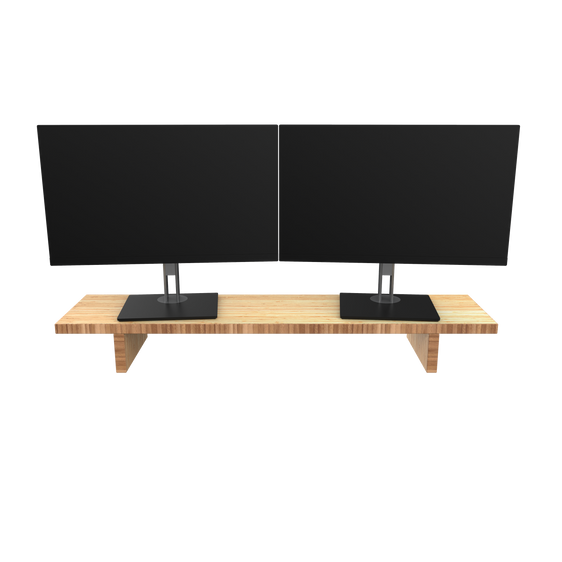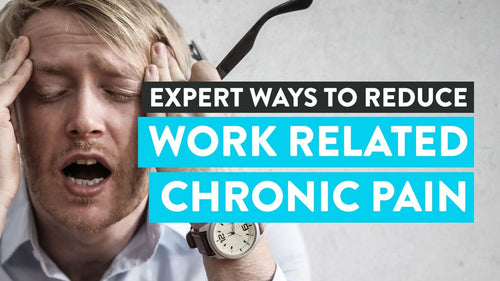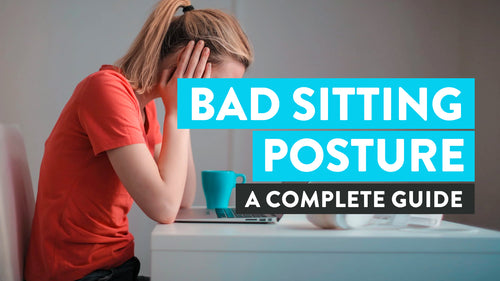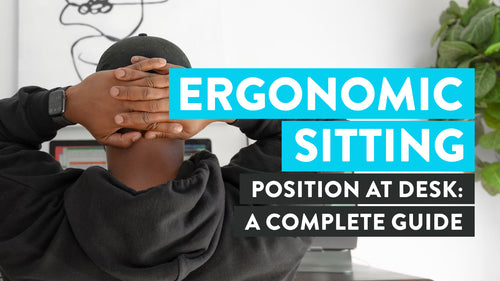
News
Sitting Problems: What Are the Sitting Risks You Should Know?
Hayden AdamsSitting for long periods has many risk factors that can jointly impact multiple areas of your body.
Excessive sitting can cause weight gain, negatively impact your mental well-being, and even increase your risk of heart disease.
It has become a worldwide issue, especially during the COVID-19 pandemic, because of the lack of space needed to combat many hours of sitting, limiting people's access to exercise and basic movement.
This quick guide illustrates how and why being too friendly with your chair can lead to a medical emergency and how to remedy the situation.
The Dangers of Prolonged Sitting

Some common injuries from prolonged sitting include hip pain, obesity, and even death in extreme cases.
Physical Health Risks
We all know that too much sitting is bad for you, and here's how.
NOTE: These dangers cover all sitting, whether in front of a computer screen, at a desk, or in your car.
Musculoskeletal Disorders
Older adults are more vulnerable to prolonged sitting due to its impact on their joints and bones. Too much sitting shortens your hip flexors, resulting in hip pain.
Past your hips and knee joints, sitting also affects your vertebral column or spine because chairs typically don't accommodate the spine's natural curve.
Obesity and Metabolic Syndrome
Weight gain is another risk of a sedentary lifestyle. Without the added energy expenditure of physical activity, gaining a few pounds is typical.
Unfortunately, that extra weight puts you at greater risk of heart attack and other health problems.
In the worst case, having too many sit-downs can increase your risk of developing metabolic syndrome, a cluster of problems like high blood sugar and cholesterol.
Cardiovascular Diseases
Sitting for long periods also increases your risk of developing cardiovascular disease or heart attacks.
A systematic review. meta-analysis and a study of daily sitting time found an association between too much sitting and heart disease.
Another study of internal medicine found that the risks can be offset by exercising more than the WHO's 1-hour daily recommendation.
Type 2 Diabetes
Too much sitting can increase your risk of developing Type 2 diabetes, eventually progressing to major complications like heart disease.
Prolonged inactivity can lead to increased insulin resistance, which physical activity may not offset.
Remember to watch your BMI (Body Mass Index,) too! Obesity can lead to diabetes and even an early death if left unchecked.
Mental Health Risks
A lack of physical activity exacts a toll on the mind and body. Here are some mental health issues that may arise from too much sitting.
Anxiety and Depression
Too much sitting can lead to feelings of anxiety and depression. Depression ruins motivation, and sitting around can cause depression to deepen.
According to the Mayo Clinic, it's unclear what connects depression, anxiety and exercise, but more physical activity can offset these issues as a healthy coping mechanism.
Cognitive Decline
One of the issues older adults may face is dementia, which can be exacerbated by too much sitting time.
Fortunately, it can be offset with mental engagement. Reading or using a computer was less neurally degenerative than watching TV.
Why Sitting is Considered the New Smoking

An occasional sit down may not seem as dangerous as smoking, but the risk factor increases with prolonged sitting.
The Similarities Between Sitting and Smoking
Here's why sitting is the new smoking.
- Cancer Risk - Both sitting and smoking can lead to various cancers.
- Heart Disease - Cigarettes and sitting raise your risk of heart attacks and other diseases.
- Can’t Be Offset - Exercise can't fully offset the effects of sitting and smoking.
The Differences Between Sitting and Smoking
Being physically inactive has risks, but here's how it differs from smoking.
- Lung Cancer - A study found that sitting for long periods didn't increase lung cancer incidence.
- Non-Communicable - Secondhand smoke can impact others, while sitting is an isolated danger, despite being easier to engage in.
The Public Health Implications
Sedentary behaviour is the fourth leading cause of death among non-contagious diseases.
During the early days of the COVID-19 pandemic, children engaged in less physical activity to stop the spread of the disease.
A study by BMC Public Health reports that this behaviour may become habitual, leading to a predominantly sedentary lifestyle for these children.
The same study reveals children as young as 6 typically spend over two hours a day in front of a screen.
Sitting time should be limited as much as possible and broken up with periods of physical activity for better health.
Understanding the Impact of Sitting Problems on Different Body Systems
Here are some of the effects of sitting on your body.
Musculoskeletal System
Spending hours in a seated position greatly impacts your skeletal muscles, like those connected to the spine and legs.
Extensive sitting shortens your hip flexors, which can cause pinched nerves and sudden pains when attempting to move.
Metabolic System
Your leg and shoulder muscles aren't the only muscle fibres affected when you sit for too long. The body's metabolism also slows when you sit around.
Since sitting relaxes the body, it conserves energy, burning fewer calories. Less work done by your muscles means more weight gained.
Cardiovascular System
Heart health is also greatly affected by prolonged sitting time.
Time spent being sedentary will harm the efficiency of your cardiovascular system, while physical activity will improve it.
A sports medicine study reports that replacing sedentary time with either sleep or exercise can lead to a healthy cardiovascular system.
DVT
Deep Vein Thrombosis, or DVT, is a blood clot that forms within your veins, typically in the abdomen or legs. In rare cases, these blood clots can travel to your lungs.
Once it reaches your lungs, you're susceptible to developing pulmonary embolism, a life-threatening condition.
High blood pressure can also lead to plaque and blood clots. Incorporate more physical activity into your day to prevent developing deep vein thrombosis.
Varicosity
If you sit down too long, blood will pool in your legs, leading to varicose veins. While this won't require preventive cardiology, it may eventually become a blood clot.
Before developing varicose veins, you can also develop spider veins, which are the smaller version and aren't serious but can be painful.
Unfortunately, this condition is more common in older adults.
NOTE: Varicose veins can develop from both excessive standing and sitting. Compression stockings may reduce their likelihood.
Nervous System
Too much sitting time can lead to pinched nerves in your neck and back, especially if you're slumped over your desk and straining yourself.
A pinched sciatic nerve can lead to discomfort and aches in your lower body called sciatica. Being sedentary raises your chances of developing sciatica.
Identifying Signs and Symptoms of Sitting Problems

Watching for these symptoms if you typically spend several hours a day sitting down.
Physical Symptoms
Some of the consequences of bad sitting posture include neck and ankle pains, along with stiffer muscles. Here are some other symptoms:
- High Cholesterol - This can lead to strokes and heart disease.
- Weight Gain - This raises your depression and cancer risk.
Mental Health Symptoms
Too much sitting time can also affect your brain. Here are some warning signs:
- Social Anxiety - A systematic review of sedentary behaviour found more sitting can lead to higher self-reported anxiety.
- Depression - Sitting's reduced energy expenditure can impact your mental well-being.
Warning Signs of Serious Health Conditions
Sitting may initially seem benign but can lead to increasingly severe issues. Excessive sitting can lead to greater risks of diseases like blood clots and even colon cancers.
A meta-analysis of studies on sedentary living found a link between prolonged sitting and colon and uterine cancer.
- Aching legs and back
- Excessively high blood pressure
- Sudden sharp pains
If you think you have any of these symptoms, visit your nearest GP or internal medicine specialist for a proper diagnosis.
Sitting Problems Prevention and Remedies
If you think you spend too much time sitting around, here are tips to improve your condition, hopefully leading to better health.
Improving Posture
Many people spend time sitting around with poor posture, which can lead to neck and back pain.
Sitting up straight is vital for older adults and children because it promotes flexibility and proper blood circulation.
Ensure neither your head nor shoulders are pulled forward. Your ears should be vertically aligned with your shoulders.
Incorporating Physical Activity
The best antidote to sedentary behaviour is to add more physical activity to your daily routine.
This doesn't have to be intensive exercise like full-body pushups; even small bursts of movement and stretches will suffice.
Movement serves a second purpose: it gives you time away from your computer and can relieve your eyes.
Regular Exercise
Extra movement may be impractical, but try to move more after work hours.
Aim for at least 150 minutes of moderately intense physical activity per week. Break it up into 30-minute chunks and stick to it every day.
Take a brisk walk around your neighbourhood or home for 30 minutes/day, and you'll exceed the 150-minute recommendation.
Breaks and Micro-Movements
Break up periods of sedentary time with frequent breaks. Stretch to promote blood flow in your legs.
It's also worth building micro-movements into your routine, like diaphragmatic breathing. Focus on expanding your stomach as you breathe for more oxygen.
Additionally, explore the idea of walking meetings if you need to discuss something with your colleague or supervisor.
Conversing while moving around is better than being stuck inside a coffee shop or boardroom. Anything to reduce your sedentary time.
Ergonomic Approaches

Sometimes being sedentary is unavoidable, but you can use ergonomics to lower your cancer risk while on the job.
Standing Desks
We've mentioned the dangers of sitting too long, so more exercise and movement is the solution. However, that's impractical in an office setting.
Fortunately, you can pick up a standing desk to work in light physical activity while you work. Standing desks can also reduce incidences of neck pain on the job.
A study on Japanese office workers reported that reducing sitting time at work helped improve stiff necks and task engagement.
If you're considering exploring standing desks vs.sitting desks, ensure you get a height-appropriate desk.
{{ spec_dual_bamboo_desk }}Active Seating Options
If you work in an office setting, you'll likely have to sit down for work. That said, you don't have to risk your well-being for work. Pick up an ergonomically-designed chair to encourage active sitting.
Your seat should properly support your spine and keep you comfortable and productive at work.
If you want to improve your health and reduce your risk of developing cardiovascular disease, look into getting a treadmill desk.
These active desks will let you exercise while on the job without cutting your screen time.
{{ spec_pro_plus_chair }}Frequently Asked Questions
Learn more about how to counter physical inactivity here!
What Are the Main Health Risks Associated With Prolonged Sitting?
Sitting for long periods has been linked with negative conditions like Type 2 diabetes and obesity, as mentioned in a study published in BMC Public Health.
You're also prone to developing poor posture when you sit for long periods, leading to other issues like a pinched nerve and stiff neck muscles.
How Can I Reduce the Impact of Sitting on My Health?
You can reduce the negative effects of too much sitting through exercise. The increased energy expenditure can improve your body and blood flow.
Take a short walk around the office during your lunch break and stretch your legs. You can still promote better health with an ergonomic chair if you need to sit at your desk to finish tasks.
A good chair should keep your hips and knees level and support your lower back.
What Are Some Simple Exercises to Alleviate Sitting Problems?
The next time you're watching TV, stand up during the commercial breaks and try some of these exercises:
- Walking - The quickest exercise is occasionally getting up and walking, whether heading to the bathroom or visiting a different cubicle.
- Toe Touches - Break up your sitting time with toe touches. Keep your feet flat on the floor and bend at the waist to touch your toes, stretching your hamstrings.
- Wall Angels - Find an empty wall at home or in the office, standing with your feet and shoulders aligned. Raise your arms to shoulder height, bending them at 90 degrees with palms facing outward. Keep your elbows, shoulders, and the back of your hands aligned with the wall, and raise your arms while inhaling. Lower them while exhaling. Keep elbows, shoulders, and back of your hands connected to the wall.
How Does Sitting Affect Mental Health?
Spending too much time in a chair can lead to feelings of depression. An online study conducted during the COVID-19 Pandemic reports that being inactive can cause greater anxiety and loneliness.
However, research suggests this also depends on what you're doing at your desk.
A different study undertook a systematic review of respondents and found that people who sit often but conduct mentally stimulating work are less likely to feel depressed.
Are Standing Desks Effective in Preventing Sitting Problems?
A standing desk is a simple and practical way to prevent issues from sitting too much.
You don't need to refer to Harvard Health Publishing to see the connection: standing doesn't cost much energy, but it's still physical activity. Standing desks can also improve your posture.
Conclusion
More movement is key to beating a sedentary lifestyle. Additional changes like proper diet, hydration, and a consistent sleep schedule can be added later.
You can minimise the risk of developing sitting issues simply by reducing your sitting time and engaging in more physical activity. Even a quick walk will beat a few hours of screen time.
Start with small changes like getting up every hour before starting more rigorous exercises not to shock yourself.








